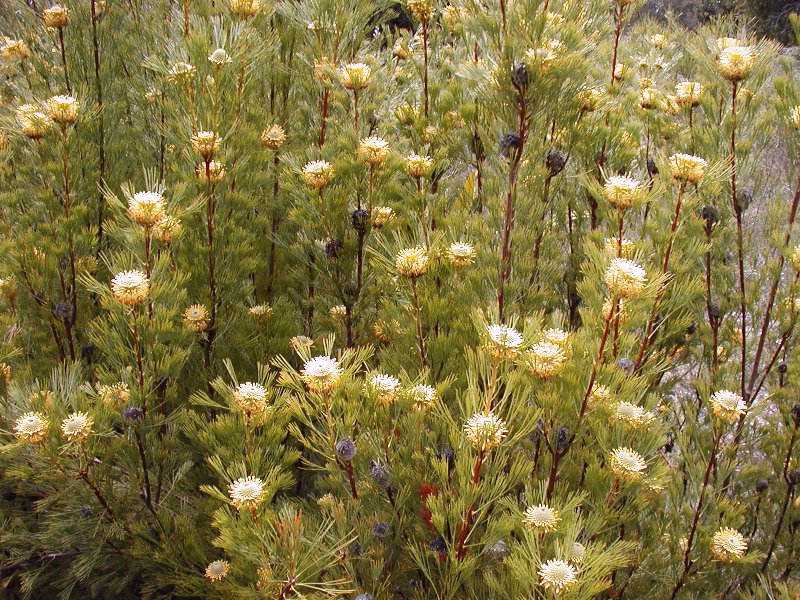|
Isopogon
''Isopogon'', commonly known as conesticks, conebushes or coneflowers, is a genus of about forty species of flowering plants in the family Proteaceae, and are Endemism, endemic to Australia. They are shrubs with rigid leaves, Plant reproductive morphology#Bisexual , bisexual flowers in a dense spike or "cone" and the fruit is a small, hairy Nut (fruit), nut. Description Plants in the genus ''Isopogon'' are erect or prostrate shrubs with rigid, usually Leaf#Divisions of the blade, compound, rarely simple leaves. Compound leaves are deeply divided with flat or cylindrical lobes. The flowers are usually arranged on the ends of branches, usually surrounded by Bract#Involucral_bracts, bracts, in a more or less conical or spherical spike. Each flower is bisexual and symmetrical, the tepals spreading as the flower develops, the lower part persisting until the fruit expands. The fruit are fused to form a woody cone-like to more or less spherical structure, each fruit a nut with bracts t ... [...More Info...] [...Related Items...] OR: [Wikipedia] [Google] [Baidu] |
Isopogon Crithmifolius
''Isopogon'', commonly known as conesticks, conebushes or coneflowers, is a genus of about forty species of flowering plants in the family Proteaceae, and are endemic to Australia. They are shrubs with rigid leaves, bisexual flowers in a dense spike or "cone" and the fruit is a small, hairy nut. Description Plants in the genus ''Isopogon'' are erect or prostrate shrubs with rigid, usually compound, rarely simple leaves. Compound leaves are deeply divided with flat or cylindrical lobes. The flowers are usually arranged on the ends of branches, usually surrounded by bracts, in a more or less conical or spherical spike. Each flower is bisexual and symmetrical, the tepals spreading as the flower develops, the lower part persisting until the fruit expands. The fruit are fused to form a woody cone-like to more or less spherical structure, each fruit a nut with bracts that eventually fall and release the fruit. ''Isopogon'' have 13 haploid chromosomes. Taxonomy The genus ''Isopogon' ... [...More Info...] [...Related Items...] OR: [Wikipedia] [Google] [Baidu] |
Isopogon Anethifolius
''Isopogon anethifolius'', commonly known as narrow-leaf drumsticks or narrow-leafed drumsticks, is a shrub in the family Proteaceae. The species is found only in coastal areas near Sydney in New South Wales, and to the immediate west. It occurs naturally in woodland, open forest and heathland on sandstone soils. An upright shrub, it can reach to in height, with terete leaves that are divided and narrow. The yellow flowers appear in the Spring, from September to December, and are prominently displayed. They are followed by round grey cones, which give the plant its common name of ''drumsticks''. The small hairy seeds are found in the old flower parts. ''Isopogon anethifolius'' regenerates after bushfire by resprouting from its woody base, known as a lignotuber, as well as from seed. It was described by Richard Salisbury in 1796, and was first grown in the United Kingdom the same year. One of the easiest members of the genus ''Isopogon'' to grow in cultivation, ''I. anet ... [...More Info...] [...Related Items...] OR: [Wikipedia] [Google] [Baidu] |
Isopogon Anemonifolius
''Isopogon anemonifolius'', commonly known as broad-leaved drumsticks, is a shrub of the family Proteaceae that is native only to eastern New South Wales in Australia. It occurs naturally in woodland, open forest, and heathland on sandstone soils. ''I. anemonifolius'' usually ranges between one and two metres in height, and is generally smaller in exposed heathland. Its leaves are divided and narrow, though broader than those of the related ''Isopogon anethifolius'', and have a purplish tinge during the cooler months. The yellow flowers appear during late spring or early summer and are displayed prominently. They are followed by round grey cones, which give the plant its common name ''drumsticks''. The small hairy seeds are found in the old flower parts. A long-lived plant reaching an age of up to 60 years, ''I. anemonifolius'' resprouts from its woody base, known as a lignotuber, after Bushfires in Australia, bushfire. Seedlings appear in the year following a fire. Al ... [...More Info...] [...Related Items...] OR: [Wikipedia] [Google] [Baidu] |

